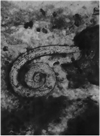Pulmonary Strongyloidiasis: The Varied Clinical Presentations
- PMID: 20111672
- PMCID: PMC2812430
- DOI: 10.1097/01.cpm.0000107609.50629.69
Pulmonary Strongyloidiasis: The Varied Clinical Presentations
Abstract
Strongyloides stercoralis is a unique parasite. It can complete its life cycle entirely within the human host. As a result, an autoinfection cycle is set up. As long as there is an intact immune system, the host can control the parasitic burden, and the organism may persist for years after the initial inoculum. Most infected individuals experience mild gastrointestinal or pulmonary symptoms that may fluctuate for years. When cell-mediated immunity becomes impaired (ie, corticosteroid use, malignancy, acquired immunodeficiency syndrome), the parasite burden will grow, disseminate, and cause hyperinfection. Strongyloidiasis is endemic in the tropical and subtropical areas of the world; additionally, it is also endemic in the southeastern United States. Strongyloidiasis is associated with asthma, preexisting lung disease, and immunosuppression, including acquired immunodeficiency syndrome. Eosinophilia is not a prerequisite; therefore, the diagnosis of strongyloidiasis requires a high index of suspicion.
Figures
Similar articles
-
Strongyloides Hyperinfection Syndrome: A Curious Case of Asthma Worsened by Systemic Corticosteroids.Am J Case Rep. 2020 Dec 21;21:e925221. doi: 10.12659/AJCR.925221. Am J Case Rep. 2020. PMID: 33347427 Free PMC article.
-
Strongyloidiasis hyperinfection after renal transplant presenting as diffuse alveolar hemorrhage with respiratory failure.Proc (Bayl Univ Med Cent). 2019 May 14;32(3):413-416. doi: 10.1080/08998280.2019.1596440. eCollection 2019 Jul. Proc (Bayl Univ Med Cent). 2019. PMID: 31384205 Free PMC article.
-
Fulminant gastrointestinal hemorrhage due to Strongyloides stercoralis hyperinfection in an AIDS patient.Rev Soc Bras Med Trop. 2013 Jan-Feb;46(1):111-3. doi: 10.1590/0037-868215522013. Rev Soc Bras Med Trop. 2013. PMID: 23563839
-
Strongyloides stercoralis infection complicating the central nervous system.Handb Clin Neurol. 2013;114:229-34. doi: 10.1016/B978-0-444-53490-3.00017-0. Handb Clin Neurol. 2013. PMID: 23829913 Review.
-
Strongyloides stercoralis.Lung. 2022 Apr;200(2):141-148. doi: 10.1007/s00408-022-00528-z. Epub 2022 Apr 9. Lung. 2022. PMID: 35396957 Free PMC article. Review.
Cited by
-
Eosinophilic pneumonias.Clin Microbiol Rev. 2012 Oct;25(4):649-60. doi: 10.1128/CMR.00025-12. Clin Microbiol Rev. 2012. PMID: 23034324 Free PMC article. Review.
-
JAID/JSC Guidelines for the Treatment of Respiratory Infectious Diseases: The Japanese Association for Infectious Diseases/Japanese Society of Chemotherapy - The JAID/JSC Guide to Clinical Management of Infectious Disease/Guideline-preparing Committee Respiratory Infectious Disease WG.J Infect Chemother. 2016 Jul;22(7 Suppl):S1-S65. doi: 10.1016/j.jiac.2015.12.019. Epub 2016 Jun 15. J Infect Chemother. 2016. PMID: 27317161 Free PMC article. No abstract available.
-
Strongyloides stercoralis hyperinfection syndrome: a deeper understanding of a neglected disease.J Parasit Dis. 2019 Jun;43(2):167-175. doi: 10.1007/s12639-019-01090-x. Epub 2019 Feb 6. J Parasit Dis. 2019. PMID: 31263320 Free PMC article. Review.
-
Parasitic necrotizing pneumonia in an immunocompetent patient in United States.J Community Hosp Intern Med Perspect. 2021 Jan 26;11(1):69-71. doi: 10.1080/20009666.2020.1824333. J Community Hosp Intern Med Perspect. 2021. PMID: 33552419 Free PMC article.
-
Present and future: Infectious tropical travel rashes and the impact of climate change.Ann Allergy Asthma Immunol. 2023 Apr;130(4):452-462. doi: 10.1016/j.anai.2022.12.025. Epub 2022 Dec 24. Ann Allergy Asthma Immunol. 2023. PMID: 36574899 Free PMC article. Review.
References
-
- Liu LX, Weller PF. Strongyloidiasis and other intestinal nematode infections. Infect Dis Clin North Am. 1993;7:655–682. - PubMed
-
- Grove DI. Human strongyloidiasis. Adv Parasitol. 1996;38:251–309. - PubMed
-
- Genta RM. Global prevalence of strongyloidiasis: critical review with epidemiologic insights into the prevention of disseminated disease. Rev Infect Dis. 1989;11:755–767. - PubMed
-
- Berk SL, Verghese A, Alvarez S, et al. Clinical and epidemiologic features of strongyloidiasis: a prospective study in rural Tennessee. Arch Intern Med. 1987;147:1257–1261. - PubMed
-
- Davidson RA, Fletcher RH, Chapman LE. Risk factors for strongyloidiasis: a case-control study. Arch Intern Med. 1984;144:321–324. - PubMed
Grants and funding
LinkOut - more resources
Full Text Sources
Research Materials


